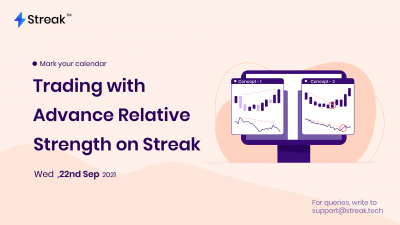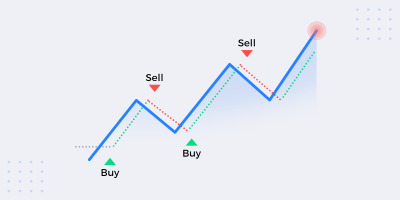One of the major pain points that traders face while looking at a chart is understanding the trend. Sometimes the price is going up, sometimes it is going down and sometimes the price does not move at all. You just see a plethora of red and green candles but cannot make much sense of the direction. It becomes very difficult to gauge the trend.
What do you do?
Well, there are several tools available to handle this situation. In this article, I will discuss one such tool that you can use to quickly identify the trend and make better decisions during trading hours.
Heikin Ashi chart is a type of chart that makes price trends easier to spot. Heikin Ashi, also spelled as Heiken-Ashi, comes from the Japanese term ‘Heikin-Ashi’ which means average price. In a similar sense, Heikin-Ashi(HA) charts represent the average pace of prices.
Heikin-Ashi chart helps in filtering out the market noise from the traditional Japanese candlestick charts. It also helps in highlighting the price trends. Though, Heiken-Ashi charts look like the candlestick charts, the calculation is different from the regular candlestick chart.
The Heikin-Ashi Formula
In candlestick charts, each candlestick shows four different prices: Open, Close, High, Low. Here each candle is independent and has no relationship with the previous or next candle. But Heiken-Ashi candles are different.
Each Heikin-Ashi candle is calculated and plotted using some information from the previous candle. The price bars are averaged and smoothed out. Heiken-Ashi (HA) candles are calculated using the following formulas:
1. The Heiken-Ashi Open is the average of the prior candlestick Open and the Close values.
| HA-Open = ( Open(-1) + Close(-1)) / 2 |
2. The Heiken-Ashi High is the maximum of three data points: the current period High, the current Open and the current Close.
| HA-High = Max (High(0), Open(0) ,Close(0)) |
3. The Heiken-Ashi Low is the minimum of three data points: the current period’s Low, the current Open, and the current Close.
| HA-Low = Min (Low(0), HA-Open(0) , HA-Close(0)) |
4. The Heiken-Ashi Close is simply an average of the Open, High, Low, and Close for the current period.
| HA-Close = (Open(0) + High(0) + Low(0) + Close(0)) / 4 |
As you must have read above, the candles of a Heiken-Ashi chart are related to each other because the Open price of each candle should be calculated using the previous one candle’s close and open prices. Similarly, the high and low prices of each candle is impacted by the previous candle.
Since the values(OHLC) are smoothened, a slight delay can be expected for the indicators to change the signal. But due to smoothening, we generally see higher accuracy signals as compared to candles. This is the advantage of using HA charts.
Trend identifications using Heiken-Ashi
There are different kinds of Heiken-Ashi candlesticks that indicates a bullish or bearish pattern.
When the trend is bullish, there is a tendency for HA candles to have long green bodies and no lower shadows. When the trend is bearish, there is a tendency for Heikin-Ashi candles to have long red bodies and no upper shadows.

Let us now observe the following images of Candlestick and Heiken Ashi charts.

As you can see in the above image, there is a lot of noise during the uptrend and the downtrend. You will observe some green candles during the downtrend (orange arrow) and some red candles during the uptrend (blue arrow).
Now we change the chartype to Heikin-Ashi.

You can observe that the chart is giving much cleaner downtrend indication, anyone can easily spot the downtrend there is lesser to no green candles during the downtrend (orange arrow). Similarly, the noise during the uptrend (blue arrow) has also reduced.
How are Heiken-Ashi charts useful?
The main difference between traditional candlestick charts and Heiken-Ashi (HA) charts is that HA draws the average price moves to display a smoother trend and removes a lot of market noise as we have seen in the previous section.
Using Heiken-Ashi charts, with your technical strategy can reduce the number of false signals and increase the strategies’ Sharpe ratio. Streak make it very simple for you to test your logic on different chart types. All you need to do go to the Advanced section in the Create page and change the chart type to Heikin-Ashi.

Pitfalls of using Heikin-Ashi
1. Heiken-Ashi charts may sometimes might give a false picture. So, it is extremely important for you to backtest your strategy on Streak using Heiken-Ashi charts to see how it performed in the recent past.
2. As I have mentioned earlier that Heiken-Ashi smoothens out the price, hence, it can also be susceptible to being late.
We covered Ichimoku Cloud and pitfalls to watch out for in our previous article. Do check that out as well.
____________
Disclaimer: The information provided is solely for educational purposes and does not constitute a recommendation to buy, sell, or otherwise deal in investments.










I’m really impressed with your writing skills as well as with the layout on your blog. Is this a paid theme or did you modify it yourself? Either way keep up the nice quality writing, it抯 rare to see a great blog like this one these days..
Pretty! This was an extremely wonderful post. Many thanks for supplying this information.
Dear sir ..